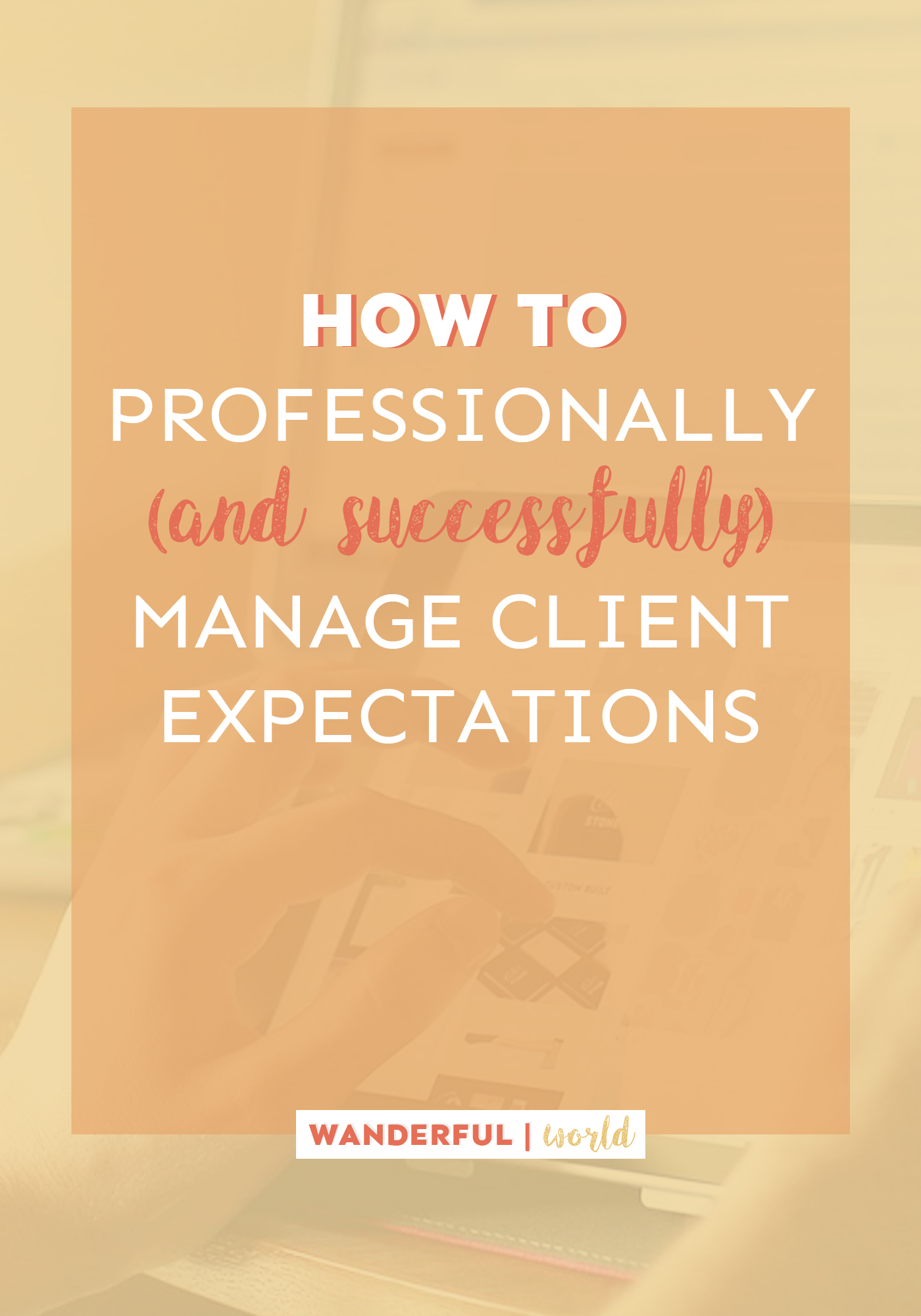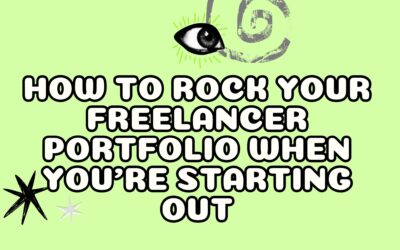Have low expectations and you’ll never be disappointed.
Ever heard this phrase before? On the one hand it makes perfect sense, but on the other? It seems kinda sad. Expectations are what make things exciting; they’re what make us look forward to something.
It’s all part of being human.
Which is why you don’t need me to tell you that all of your freelance clients will have expectations of some kind, from what it’s like to work with a freelancer, to the exact outcome they’re hoping for.
Now, client expectations can be a good thing and a bad thing. They’re good because you know what it is a client wants, and they’re bad because sometimes those expectations are waaay out of reach.
So how do you get everyone singing from the same hymn sheet? And why is it important?
Before we begin, don’t forget to download your checklist of things to do AFTER you land a client, as well as grab your list of questions to ask new clients.

Why It’s Important to Manage Client Expectations
Do you really need me to spell out why it’s important for you to manage your client’s expectations as a freelancer?
It’s important because it means you’ll both know what to expect (duh, they’re expectations!), but it also means that there won’t be any nasty surprises and both you and your client will leave the project feeling happy and satisfied.
The Dreaded Scope Creep
What the heck is scope creep? I hear you ask.
This is when a client will keep asking for more and more without paying extra. It might start with something small, like “can you just add a paragraph about this?” and then blow up into a whole boatload of resentment and late night worrying.
Managing your client expectations can help avoid scope creep because, if you do it right (which we’ll discuss below), you’ll both know exactly what the project involves and what it doesn’t.
No nasty surprises.
Truth time: don’t assume a client is in the know
First things first: YOU are in control of managing your client expectations.
Why? Because YOU are the person who knows your industry best. YOU are the person who’s done this work before. Your client on the other might never have worked with a freelancer before or worked on a similar project.
Which makes it your job to inform them of what it’ll be like and what they can expect.
Don’t assume a client knows how you work and don’t assume they know what goes into working with a freelancer.
Alrighty, so now I’ve sufficiently scared you, let’s dig into how you can professionally manage your client expectations.

How to Professionally Manage Client Expectations
1. Know your work inside out (and map it out)
Before you even start working with any client, I beg you to put a process in place. Kinda like a boilerplate for all projects that you can tweak and play with accordingly.
This should include everything from what steps should be taken after the client has signed the contract/signed off the first draft/paid the deposit etc, as well as how you schedule your work, when you can deliver by, and what prices you charge.
Your process might look something like this:
- Step 1. Agree on exact scope of work and send a contract to client.
- Step 2. When contract is signed, client sends across all relevant information and pays a 50% deposit.
- Step 3. When client has sent across all relevant information, you create an outline (if you’re a writer).
- Step 4. When the outline has been approved, work on the first draft can begin.
- Step 5. When the first draft has been approved, work on the final draft can begin.
- Step 6. When the final draft has been approved, client pays the remaining 50%.
This is a very simple example of what your process might look like, but it’s worth having it mapped out so you can let the client know the timeline of the project, when you need their input, and the exact steps they can expect to take to move things forward.
2. Lay It Out in Laymen Terms
When you communicate your process to your client and what they can expect working with you to look like, you want to literally write it out as simply as possible.
Write it out in an email with bullet points for each step or, even better, put it in your contract.
Make sure you both agree on the timelines, the price, and what exact work will be carried out so, again, there’s no nasty surprises.
3. Have Open Communication … But Not Too Open
Communication is key if you want a project to run smoothly. Letting your client know where you’re at throughout the project can give them peace of mind that things are moving forward.
You can drop them an email when:
- You’ve started the project
- You’ve reached a specific milestone
- You’ve realised it might take longer than you thought
- You need further clarification
- You need their input on something
But while you want to keep an open line of communication to ease any client worries, you also don’t want the line to be too open.
Yes, your clients should be able to email you if they have a question, but they shouldn’t expect an immediate response.
In this case, I always state something like, “I’ll try my best to reply to emails within 48 hours” in the contract or in a written agreement.
You can also set specific office times so they know when you’ll be answering your emails (which avoids them sending you an urgent email at 9pm on a Saturday – nightmare!).

4. Be Honest and Take Responsibility
As a freelancer, it’s really important that we own everything we do (and not in a “this belongs to me” kinda way). We need to take responsibility for what we’re doing and why we’re doing it and explain this to clients.
I’m always terrified of telling clients when something goes wrong or I might not be able to do a project the way they expected for whatever reason.
But guess what? They have never fired me or shouted at me or told me how disappointed they are. They’ve been entirely understanding and have tried to help me in whatever way they can.
Because the truth is this: people generally want to help. They are NOT out to get you!
Knowing this makes it a whole lot easier to be honest and take responsibility for your actions. Your business relies on it – clients want to work with freelancers they can trust, and that means sharing the good news AND the bad news when it comes to projects.
Not only does it build trust, but it helps ease client expectations. If you’re telling them you can do something one way but you’re pretty sure you can’t, they’re expectations are going to be skewed, right?
5. Listen!
Finally, this should be something you do every day, whether you’re working with a client or simply having coffee with a friend.
Listening is the number one way you can get a grasp on your client’s expectations and understand what exactly it is they’re looking for.
A lot of the time, clients will be vague with their requirements. They’ll say something like, “Oh, we’re not exactly sure what it is we want, so work your magic and be creative.”
Then you’ll hand in the project and they’ll be disappointed. Because, really? They DO know what they want. They might not be exactly sure, but at the back of their mind they have an idea of how they want things to turn out.
This is why listening is SO important. You can often read between the lines and get an understanding of what it is your client wants. For example:
- Do they keep mentioning a specific brand? Chances are they want to be like this brand.
- Do they use specific words? Chances are they want these words and the general feel of their “talk” to be implemented in the project.
- Do they say what it is they DON’T want? This can be a great way to decipher what they DO want.
When you start listening to your clients (and by listening I also mean listening to what they’re not saying and reading between the lines), you’ll be able to determine what your client values the most.
And in turn, this means you’ll have a better understanding of their expectations and how you can manage them.
Tell me, do you have an interesting story about client expectations? Maybe you misread what a client really wanted or they weren’t clear on what they expected? Share it in the comments below! You’re not alone, I promise!







What a great post! Very on point and full of super helpful information! It really is all about honest communication and clearing things up before they turn into a mistake/discontent! 🙂
Luna recently posted…4 Years Of Adventures
Thanks Luna! So glad it’s useful 🙂 if there’s one thing I suggest all freelancers need to be, it’s honest.
I love #4 – Be Honest and Take Responsibility. Sometimes it takes guts to be honest, but it’s always for the best! Great post – thanks for sharing!
So true – it’s always, always for the best! Thanks for stopping by, Angela 🙂